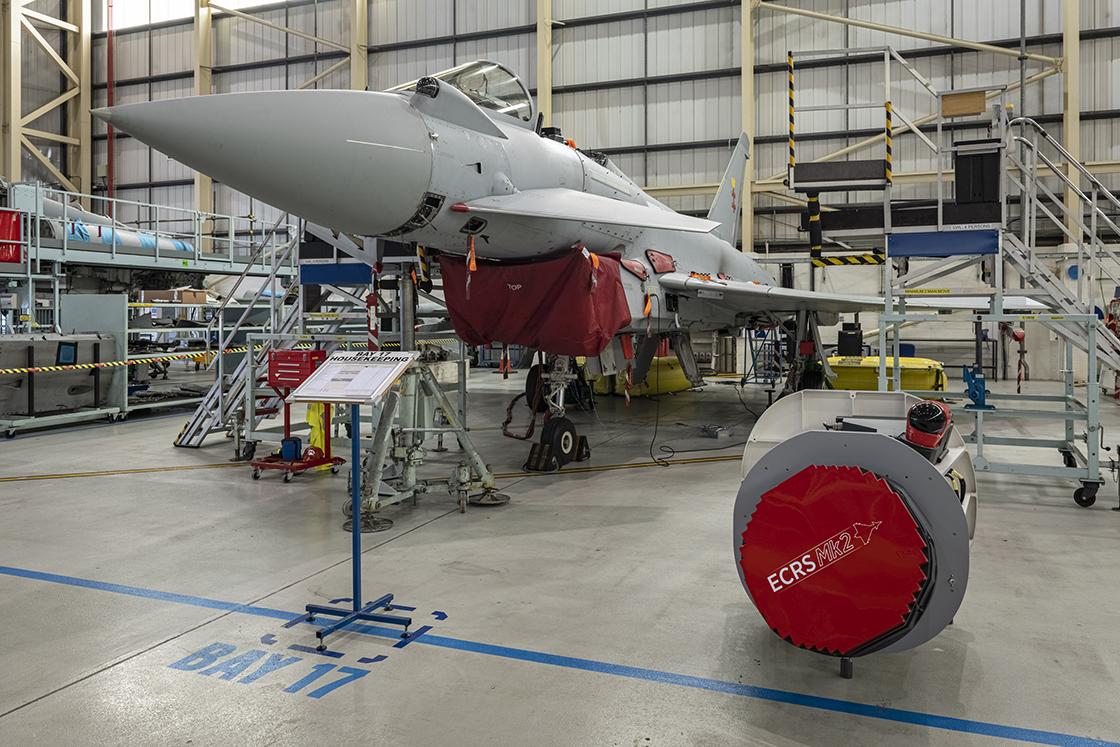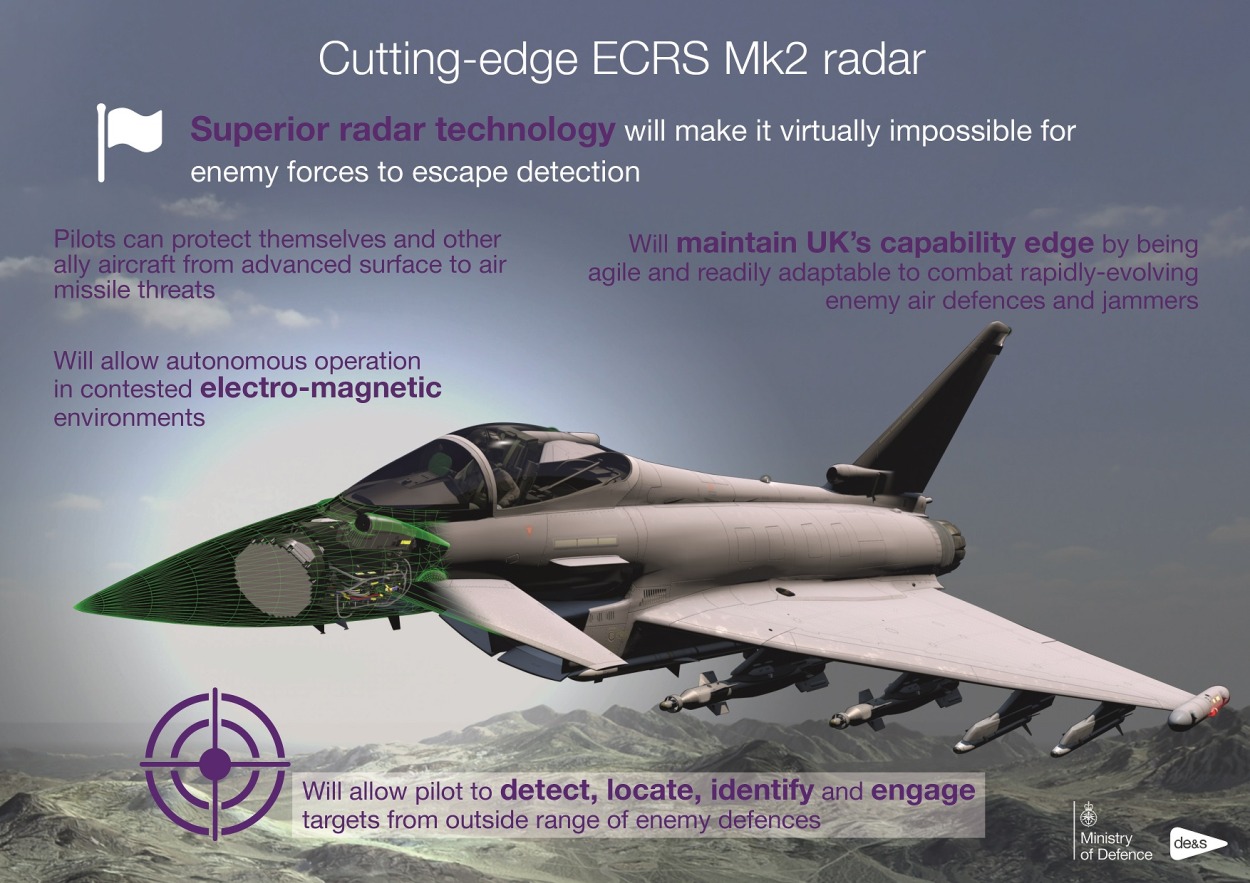To add more teeth to the British Eurofighter Typhoon fighter jets, an advanced Active Electronically Scanned Array (AESA) radar has been installed on the fourth-generation Eurofighter Typhoon by BAE Systems and Leonardo UK.
The two companies announced that engineers from BAE System and Leonardo UK installed the European Common Radar System (ECRS) Mark 2 (Mk2) prototype (also known as the Captor-E Mk 2) on BS116, a UK test and evaluation Typhoon jet. While Leonardo UK has developed the system, BAE Systems has incorporated the ECRS (European Common Radar System) Mk 2 onto the Typhoon.
Ahead of a maiden flight by this cutting-edge war machine, the ECRS Mk 2 radar has been installed on the Typhoon. The radar reportedly has a unique positioning mechanism that will bolster the combat capability of this Royal Air Force (RAF) aircraft.
The much-anticipated radar is expected to give the RAF Typhoons many new capabilities that will enable the aircraft to support the United Kingdom’s F-35B stealth jets more effectively. It is speculated that it will also eventually interest other European aircraft users.
Although it’s taken a while, BAE Systems claims that the ECRS Mk 2 is “the world’s most capable combat air radar.” The radar, still in the prototype phase, was put in a Typhoon test plane at the end of last year. After ground testing this year, flying trials of the aircraft and its enhanced radar are anticipated to commence at BAE’s Warton, Lancashire, base.
The advanced radar has a multi-functional array (MFA) for electronic warfare and search and tracking applications. The two defense giants noted that the radar will be “able to locate and deny the use of an adversary’s radar with a powerful electronic jamming attack while staying beyond the reach of threats.”
The development and integration of this radar is part of the £2.35 billion (US$2.97 billion) Eurofighter upgrade program announced in July 2022. The upgrade program seeks to maintain the Eurofighter jet as an effective combat force for the next two decades.

At the time of announcing the vaunted upgrade program, UK Minister for Defense Procurement Jeremy Quin had said that “The upgrade plan “includes the delivery of the state-of-the-art European Common Radar System (ECRS) Mk 2 radar and work also ensures the aircraft can integrate additional capabilities and weapons later in the decade to counter emerging threats until 2040 and beyond.”
The UK is also developing a sixth-generation aircraft under the Global Air Combat Program (GCAP) in collaboration with Japan and Italy. However, since the aircraft would not enter service until 2035, the RAF has taken upon itself the responsibility to upgrade the capabilities of its existing Eurofighter fleet, which is the bulwark of its air power.
The Eurofighter Typhoon is a delta-wing, beyond-visual-range, close-air fighter jet with exceptional capabilities for conducting air-to-air and air-to-ground attacks. The plane can also maintain speeds of over Mach 1 without using the afterburner. It has two Eurojet EJ 200 engines, each capable of providing a 90kN thrust in full reheat and 60kN in dry power mode.
It was reported last year that the radar will be equipped on the Royal Air Force’s (RAF) fleet of 40 Tranche 3 Eurofighters at the end of the decade.
The RAF currently has a fleet mainly composed of Tranche 1, Tranche 2, and Trance 3 variants of Eurofighter Typhoons, but only the latest tranche of the aircraft, which was built with the internal wiring and infrastructure necessary to accommodate the installation of the newest radar, will be equipped with it.
What Makes ECRS Mk2 Deadly?
As per a previous statement made by the manufacturer, the ECRS Mk 2 radar will further transform the Eurofighter Typhoon’s control of the air, bringing a world-leading electronic warfare capability that will allow the aircraft to simultaneously detect, identify, and track multiple targets in the air and on the ground.
“It will support operations in the most challenging situations, equipping pilots with the ability to suppress enemy air defenses using high-powered jamming and engage targets while beyond the reach of threats.”
The new radar will have a new processor, receiver, and generator for electronic warfare. The radar will have a wider field of vision thanks to a new mechanism for rotating the swashplate, especially during aerial encounters beyond sight range. Additionally, a recently constructed, mainly made radome conceals the radar’s antenna.
This radar’s ability to retain radar surveillance of an aerial target beyond 90 degrees allows a Typhoon to conceal itself in the Doppler notch and still deliver targeting updates to its missiles, which is a significant advantage in some air-to-air situations.
“The radar’s processor, receiver, and antenna power supply and control units have all been re-engineered to further enhance the capacity, capability, and performance of the Mk 2 system in alignment with the new antenna and electronic warfare capability. These production designs have all passed their critical design review phases, keeping the production program on schedule,” according to Ross Wilson, VP Engineering, Radar, and Advanced Targeting, Leonardo UK.
To “further enhance the capacity, capability, and performance of the Mk2 system in alignment with the new antenna and electronic warfare capability,” he continued, the radar’s processor, receiver, antenna power supply, and control components had “all been re-engineered.”
According to Wilson, the production timetable is being maintained since all the recent production designs have completed their crucial design review stages.

Experts emphasized that the radar’s high power and colossal antenna make it extremely sensitive. This will allow Eurofighter to carry out electronic surveillance to find radar emitters and provide further stand-off air-to-surface capabilities. Adversary radars will be susceptible to degradation by an electronic attack capability.
BAE Systems explained, “Eurofighter Typhoon will be able to locate and deny use of an adversary’s radar with a powerful electronic jamming attack while staying beyond the reach of threats.”
Unspecified “advanced air-to-surface capabilities” and secure datalink modes, which allow the radar to be used for high-bandwidth communications, are known features of the ECRS Mk 2.
According to the Royal Air Force, the ECRS Mk 2 is expected to begin operating in 2030. However, they note that this date may be moved up “if required.” Even if it might take a while to arrive, the ECRS Mk 2 will provide the British Typhoon fleet a significant boost in capabilities and boost the export potential of the Tranche 3 variant of the aircraft.
- Contact the author at sakshi.tiwari9555 (at) gmail.com
- Follow EurAsian Times on Google News




